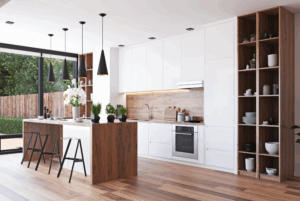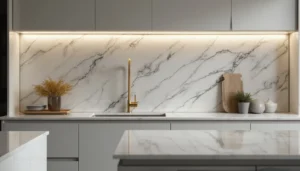Why Summer is the Perfect Time for Basement Remodeling
Benefits of Remodeling During Warm Weather
Summer is an ideal season for tackling smart basement remodeling projects due to several favorable factors:
Better Ventilation
Warm weather allows for better ventilation by keeping windows and doors open, enhancing air circulation. This improved airflow is particularly beneficial during construction, as it helps dissipate fumes and dust, keeping the workspace comfortable and safe.
Easier to Move Furniture and Materials
The absence of snow, ice, and rain during summer makes transporting heavy furniture and construction materials more manageable and less hazardous.
Extended Daylight Hours
Longer days provide extended natural light, speeding up the project’s progress as more work can be done during daylight hours. Natural light also offers better visibility, which is crucial for detailed tasks.
Dry Conditions
Dry weather conditions are essential for preventing mold growth and water damage. The dry summer air ensures that construction materials remain in good condition, reducing complications during the remodel.
Common Summer Basement Remodeling Projects
Popular summer remodeling projects that can transform your basement include:
Finished Basements
Turning unfinished basements into functional living spaces is a popular interior upgrade. This project boosts your home’s value and adds versatile living areas without expanding your home’s footprint.
Basement Home Theaters
Creating comfortable, cool spaces for movie nights away from the summer heat can offer entertainment and relaxation. Adding soundproofing and comfortable seating can enhance the cinema experience.
Family Entertainment Areas
Establishing multipurpose zones for games, relaxation, and family gatherings can create a dynamic space. Features like gaming consoles, a pool table, or a mini-bar make these areas family favorites.
Home Gyms
Setting up fitness areas allows for convenient workouts at home, catering to fitness enthusiasts who want to maintain their routines without leaving the house.
Guest Rooms
Providing cool, comfortable spaces for visitors ensures a welcoming stay. Including an en-suite bathroom and a small kitchenette can offer guests privacy and convenience.
Planning Your Summer Basement Remodeling Project
Assessing Your Basement Needs
Before starting any remodeling project, it’s important to evaluate your basement’s current condition:
Evaluating the Current Condition
Inspect your basement for signs of moisture, dampness, or mold. Check the foundation walls, floors, and ceilings for any cracks or damage that need attention. This evaluation helps you understand the scope of work required and prioritize immediate repairs.
Identifying Potential Issues
Address issues like poor ventilation, outdated electrical wiring, or insufficient insulation to ensure a comfortable and safe space. Conducting a thorough inspection can save you time and money by preemptively solving potential problems.
Setting Goals for the Project
Define your remodeling objectives, whether it’s creating a living area, home office, or entertainment space. Clearly outlining your goals will guide design choices and help you stay focused and within budget.
Budgeting for Smart Basement Remodeling
Effective budgeting is crucial for a successful remodeling project:
Estimating Costs for Materials and Labor
Research the costs of materials such as flooring, drywall, lighting fixtures, and insulation. Obtain quotes from contractors for labor costs to gain a comprehensive understanding of the expenses involved.
| Item | Estimated Cost ($) |
|---|---|
| Flooring (per sq. ft.) | $3 – $12 |
| Drywall (per panel) | $10 – $20 |
| Lighting Fixtures | $50 – $150 |
| Insulation (per sq. ft.) | $1 – $3 |
Creating a Realistic Budget
Consider all potential expenses, including permits and inspections, and add a contingency buffer of 10-15% for unexpected costs. This buffer provides financial flexibility and peace of mind.
Budgeting for Unexpected Expenses
Allocate a financial cushion to handle unforeseen issues, such as structural surprises or additional materials. Regularly monitor expenses to stay on track with your budget.
Gathering Inspiration
Finding inspiration can help you visualize your ideal basement:
How to Find Design Inspiration
Browse home design websites, magazines, and social media platforms like Pinterest and Instagram for ideas that fit your style and needs. Save and share inspirational ideas and look for designs that align with your preferences.
Popular Trends
Stay updated on the latest trends, such as open floor plans, home theaters, and built-in storage solutions. These trends can enhance the visual appeal and functionality of your basement.
Using Platforms
Utilize platforms like Houzz, which offer a wide collection of design ideas and allow you to connect with professionals for advice and services. You can use these tools to create mood boards and save images that inspire you.
Smart Basement Remodeling Ideas for the Summer
Creating a Cool and Comfortable Living Space
Maneuver through design elements to maintain a cool, comfortable living space despite the summer heat:
Insulation and Ventilation Solutions
Proper insulation and mechanical ventilation systems, or dehumidifiers, ensure air quality and stable temperatures. Focus on insulating walls, ceilings, and floors to maintain comfort and energy efficiency.
Installing Energy-Efficient Windows
Use windows with low-emissivity (Low-E) coatings to reflect heat and improve insulation, reducing cooling costs. Properly sealed windows also contribute to better temperature control and energy efficiency.
Choosing Cool Color Schemes and Materials
Opt for light colors that reflect heat and make the space appear brighter. Consider materials like engineered wood, laminate flooring, or vinyl tiles, which are cooler to the touch compared to traditional carpeting. These choices can make a significant difference in overall comfort and aesthetics.
Designing a Multi-Purpose Space
Maximize functionality by designing a versatile basement:
Home Office, Gym, or Guest Room
Adapt sections of your basement to serve multiple functions, such as a home office for uninterrupted work, a gym for fitness, or a guest room for visitors. This approach ensures flexible use of space according to changing needs.
Flexible Basement Layout
Incorporate movable partitions to create distinct zones for different activities. A flexible layout allows you to easily reconfigure the space as needed, enhancing its adaptability.
Smart Storage Solutions
Implement built-in shelving, under-stair storage, and multipurpose furniture with hidden compartments. Efficient storage solutions keep the basement organized and clutter-free, adding to its functionality.
Kid-Friendly Basement Ideas
Create safe and engaging spaces for children within the basement:
Creating a Playroom or Entertainment Area
Dedicate areas with child-sized furniture, soft flooring, and interactive elements like chalkboard walls or climbing features. A playful design keeps children engaged and provides a conducive environment for creative activities.
Safety Tips
Ensure play areas are free of sharp edges and hazardous materials. Childproof electrical outlets and install safety gates on stairs for additional protection. These measures ensure a secure space for children to play and explore.
Fun Design Elements
Incorporate bright colors, wall art, and interactive features to create an inviting and stimulating environment for children. Durable, easy-to-clean materials are ideal for handling spills and messes.
Adding a Basement Bathroom
Adding a bathroom enhances functionality and convenience:
Benefits
A basement bathroom adds practicality, particularly if the basement is used as a guest room or entertainment area, reducing the need to go upstairs. It also increases your home’s value by providing additional facilities.
Plumbing and Ventilation Considerations
Choose the best location based on existing plumbing. Proper ventilation is crucial to prevent moisture buildup and maintain a fresh environment. Ensure compliance with local building codes.
Stylish and Functional Design
Opt for compact, space-saving fixtures and high-quality finishes to create a luxurious feel. Thoughtful design choices contribute to the bathroom’s functionality and aesthetic appeal.
DIY vs. Hiring Professionals
Pros and Cons of DIY Basement Remodeling
Consider the benefits and challenges of a DIY approach:
Pros:
- Cost savings on labor.
- Personal satisfaction from completing the project yourself.
- Full control over the project.
Cons:
- Time-consuming without experience.
- Higher risk of mistakes.
- Limited expertise for specialized tasks.
When to Hire Professionals
Recognize when professional help is necessary:
Tasks Requiring Expertise
Structural changes, electrical work, plumbing, and HVAC installations should be handled by professionals to ensure safety and compliance with codes.
Finding Reputable Contractors
Seek recommendations, check online reviews, and verify credentials. Obtain multiple quotes for comparison and choose contractors with good track records.
What to Expect During the Remodeling Process
Clear Communication
Maintain open communication with your contractor throughout the project. Regular updates and check-ins ensure the work progresses smoothly and aligns with your vision.
Understanding Project Timelines
Get a clear understanding of the project’s timeline, including potential delays. Be prepared for disruptions, especially if the remodeling affects essential areas of your home.
Ensuring Quality Work
Ensure contractors follow agreed-upon specifications and maintain a high standard of workmanship. Conduct periodic inspections and address any issues promptly to ensure quality and satisfaction.
Ensuring a Successful Basement Remodel
Permits and Regulations
Compliance with local building codes is crucial:
Understanding Permit Requirements
Research and understand relevant permits and local building codes to ensure compliance. Different areas have different regulations, which dictate what’s permissible in terms of house construction or renovations.
Steps to Obtaining Permits
- Research: Visit your local government’s website or office to find out the specific permits needed for basement projects.
- Application: Fill out and submit necessary permit application forms. This may include detailed plans or blueprints of your proposed work.
- Inspection: An inspector may visit your space to confirm that your plans comply with local codes.
- Approval: Once all checks are done, you will receive permits. Ensure they are accessible throughout your project.
Staying on Schedule
Maintain efficiency with a robust timeline:
Creating a Timeline
Outline each project phase, setting realistic weekly or monthly goals.
| Phase | Duration |
|---|---|
| Planning and Design | 2-3 weeks |
| Permitting | 1-2 weeks |
| Demolition | 1 week |
| Framing and Insulation | 2 weeks |
| Electrical and Plumbing | 2-3 weeks |
| Drywall and Finishing | 3-4 weeks |
| Flooring and Painting | 2 weeks |
| Final Touches | 1 week |
Tips for Staying on Track
Regular check-ins with contractors, buffer time in your schedule for unforeseen delays, and prioritizing critical tasks ensure project timeliness.
Avoiding Common Basement Remodeling Pitfalls
Prevent common issues with proactive measures:
Common Mistakes to Avoid
Poor moisture management, insufficient lighting, and low ceiling height can complicate basement remodeling. Ensure thorough planning to prevent these issues.
Successful Project Management Tips
- Detailed Planning: Invest time in thorough planning to avoid scope creep.
- Quality Materials: Use high-quality, moisture-resistant materials for longevity.
- Professional Help: Hire professionals for specialized and complex tasks.
Post-Remodeling Considerations
Maintenance Tips for Your New Basement Space
Ensure your basement remains in top condition:
Keeping it Mold-Free
Use dehumidifiers and promptly fix any plumbing leaks or water seepage. Maintaining humidity levels below 60% is key.
Routine Maintenance
Conduct regular cleanings and inspections to address minor issues before they escalate. Check for signs of water damage or leaks frequently.
Making the Most of Your Remodeled Basement
Fully utilize your new space for various activities:
Hosting Gatherings
Create zones for home theaters, game rooms, or bar areas to enjoy social events.
Year-Round Enjoyment
Adapt the space for winter comfort or various activities, making it versatile for all seasons.
Inspiring Stories from Successful Remodels
Learn from others’ successes to inspire your project, such as creating a family game room, a home gym, or a guest suite.
Conclusion
Transforming your basement into a cool, stylish, and functional living space is a fantastic warm weather project. Summer provides ideal conditions for smart basement remodeling, including better ventilation, extended daylight hours, and dry conditions. Proper planning, budgeting, and consideration of both DIY and professional options ensure a successful project.
By adding versatile spaces such as home offices, gyms, or entertainment areas, and paying close attention to insulation, ventilation, and smart design choices, your remodel will be effective and enjoyable. Ensuring compliance with permits, adhering to a well-planned schedule, and avoiding common pitfalls will keep your project on track.
Post-remodeling, maintaining your basement through regular cleaning and addressing moisture issues, and exploring innovative usage of the space will enhance your home’s value and provide a year-round enjoyable area. Start planning your project today and turn your basement into a dream space that fits your needs and lifestyle.
With comprehensive insights, your journey through warm weather projects and smart basement remodeling for the summer will be informed and inspiring. Whether creating a cozy family retreat or a dynamic entertainment hub, a beautifully remodeled basement can significantly enhance your home’s functionality and charm.






